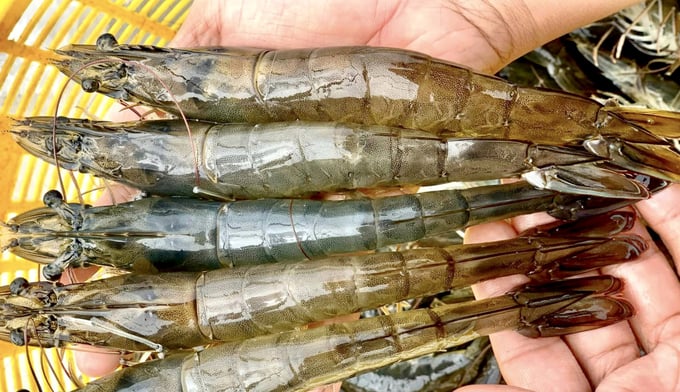November 26, 2025 | 10:43 GMT +7
November 26, 2025 | 10:43 GMT +7
Hotline: 0913.378.918
November 26, 2025 | 10:43 GMT +7
Hotline: 0913.378.918

Vietnamese shrimp holds great potential in the UAE market thanks to the CEPA. Photo: Son Trang.
Shrimp and tuna are two of Vietnam's main seafood export products. These items have been exported to the UAE market for many years. These seafood items have gained strong traction in the UAE market due to their high quality and competitive pricing. Vietnamese shrimp, known for its fresh taste and high nutritional value, while Vietnamese tuna is favored for its versatility in various dishes, from traditional Arabic meals to international seafood platters.
According to the Vietnam Association of Seafood Exporters and Producers (VASEP), the UAE is currently among the top 20 markets for Vietnamese shrimp, with an annual export turnover of around USD 20 million. Between 2018 and 2022, the UAE ranked 16th among Vietnamese shrimp export markets, accounting for about 0.5% of the total shrimp export turnover.
After a decline in 2023, shrimp exports to the UAE have seen a strong rebound this year. In the first nine months of this year, shrimp exports to this market reached USD 7.4 million, a 34% increase compared to the same period in 2023, accounting for 0.3% of the total shrimp export turnover.
Ms. Kim Thu, a shrimp market expert at VASEP, noted that the main shrimp products exported to the UAE include frozen black tiger shrimp, steamed frozen PD whiteleg shrimp, fresh frozen EZP shrimp, whole frozen black tiger shrimp, steamed frozen whiteleg shrimp, fresh frozen PD shrimp, breaded frozen whiteleg shrimp, fresh frozen whiteleg shrimp, and fresh frozen Nobashi whiteleg shrimp.
In the UAE market, Vietnamese shrimp faces competition from two strong rivals: India and Ecuador. India currently occupies 60-70% of the UAE's imported shrimp market share due to its effective tax advantages, while Ecuador, a newer player in the UAE market, has captured 15% of the market share.
Compared to these two suppliers, Vietnamese shrimp faces disadvantages both globally and in the UAE due to higher production costs. The two most important factors for competition in the UAE shrimp market are price and quality. Vietnamese shrimp is of high quality, but due to price disadvantages, it currently holds only a 5-7% market share.
While export turnover to the UAE remains modest, this market is still considered a potential market for Vietnamese shrimp. The UAE serves as a crucial gateway, facilitating access of Vietnamese seafood in general and shrimps in particular to and expansion into Middle Eastern, African, and European markets. With the newly signed CEPA, Vietnamese shrimp will receive the highest, earliest tax incentives, which could help increase its market share in the UAE.

Vietnam is currently one of the top three suppliers of tuna to the UAE. Photo: Son Trang.
Not only shrimp, but another Vietnamese seafood product, tuna, will also see increased export opportunities in the UAE market thanks to the CEPA. According to VASEP, tuna exports to the UAE have continuously grown since 2021. In 2023, tuna exports to the UAE reached nearly 4 million USD, a 139% increase compared to 2019.
Vietnam is currently one of the top three suppliers of tuna to the UAE. Vietnamese tuna imported into the UAE mainly includes frozen tuna meat/loin products, as well as canned tuna.
Currently, imported tuna in the UAE is subject to a 5% tax. With the CEPA, as import taxes on Vietnamese seafood are reduced to 0%, Vietnamese tuna will gain a significant competitive advantage over other suppliers in the market. This presents an opportunity for Vietnamese tuna to expand its market in the UAE in the coming time.
Despite the advantages from the CEPA, VASEP states that for Vietnamese shrimp or tuna to be exported to the UAE more smoothly, businesses need to establish Halal certification systems for shrimp and tuna products destined for this market.
Seafood consumption in the UAE is on the rise due to population growth, increased income, and a growing consumer preference, especially among the younger generation, for seafood protein. Currently, per capita seafood consumption in the UAE is higher than the global average. Additionally, agriculture accounts for less than 1% of the UAE’s economy, meaning that 90% of the country’s seafood consumption is imported. With the UAE’s economy being very stable, these are significant factors for Vietnam to boost exports of shrimp, tuna, and other seafood to the UAE once the CEPA officially takes effect.
Translated by Kieu Chi

(VAN) An Giang promotes supply-demand connections, standardizes quality and builds value chains, creating a foundation for sustainable bird’s nest development and aiming to expand exports.
/2025/11/24/5339-4-nongnghiep-075331.jpg)
(VAN) Recently, the conference on 'Sustainable Fisheries Linkage Chain - Tilapia for Export' took place in Tien Hai commune, Hung Yen province.
/2025/11/21/4309-2-153400_128.jpg)
(VAN) Green and low-emission rice is paving the way for Vietnamese rice to enter high-end markets, marking the beginning of a transformation journey toward greening and elevating the national rice brand.

(VAN) ‘Right to Win’ outlines a national action plan that shapes a new vision for Viet Nam’s agriculture in an era of renewal and global integration.

(VAN) Lam Dong’s farmed sturgeon output this year is expected to reach 2,300 tons, worth VND 450 billion, affirming the brand’s position on the market.

(VAN) A surge in Ukrainian egg exports, largely driven by soaring sales to the UK over the last few years, has notably pushed up egg prices on the domestic market.

(VAN) The price of Arabica Catimor coffee in Quang Tri is currently at VND 25,000–27,000/kg (fresh cherries), the highest level ever recorded